Many people often ask, "Is OpenAPI the same as Swagger?" or "Has Swagger been renamed to OpenAPI?" In reality, Swagger and OpenAPI are two widely-used API specifications in RESTful API development. While they share similarities, there are important distinctions between the two. This article aims to clarify these differences and help you make an informed decision.
What is Swagger?
Swagger, an open-source software framework, was initially released in 2011 and has since played a crucial role in the development of RESTful APIs. It empowers developers by offering a comprehensive suite of tools and functionalities. With Swagger, developers can effortlessly design, build, document, and test their APIs. One of the notable features of Swagger is its user-friendly interface, which allows developers to visualize and interact with API resources without the need for manual coding.

Swagger simplifies API development by providing an intuitive interface where developers can define the various endpoints, parameters, responses, and other important aspects of their APIs. It offers a streamlined experience by automatically generating interactive API documentation, making it easier for developers and users to understand and utilize the API's capabilities. Additionally, Swagger includes powerful tools that facilitate the generation of client libraries and server stubs in multiple programming languages, promoting efficient integration and adoption of APIs across different platforms.

What is OpenAPI?
OpenAPI, previously known as Swagger 2.0, is a specification developed by the OpenAPI Initiative—a consortium of industry leaders such as Google, IBM, Microsoft, and others. OpenAPI serves as an open standard for describing RESTful APIs, providing developers with a structured approach to defining the structure and behavior of their APIs. This specification employs commonly used formats like JSON or YAML, making it machine-readable and easily understandable by both humans and computers.
OpenAPI extends the capabilities of its predecessor, Swagger, by offering a more comprehensive and standardized approach to API description. It allows developers to define not only the endpoints and their parameters but also provides support for advanced features such as authentication mechanisms, error handling, and data validation. By adhering to the OpenAPI specification, developers can ensure that their APIs are well-documented, interoperable, and easily consumed by others.
OpenAPI's development was initiated by the OpenAPI Initiative in 2015, and since then, it has gained significant traction in the API development community. The specification is continuously improved and maintained, with regular updates and new versions being released to address emerging requirements and incorporate industry best practices.
As the industry embraced the OpenAPI standard, it became evident that OpenAPI was more than just a name change from Swagger 2.0. It signified a broader commitment to openness, collaboration, and standardization in API development.

Swagger vs OpenAPI: 4 Best Key Differences
There are significant differences between Swagger and OpenAPI:
- Origins: Swagger originated as a software framework developed by Tony Tam and his team at Reverb Technologies in 2011. It aimed to simplify the design, development, and documentation of RESTful APIs. OpenAPI, on the other hand, was developed as a specification by the OpenAPI Initiative, a consortium of industry leaders including Google, IBM, and Microsoft. It built upon Swagger 2.0 and became a language-agnostic and extensible standard for API description and definition.
- Focus: Swagger initially focused on providing a comprehensive set of tools for API design, development, and documentation, with an emphasis on intuitive and interactive documentation. OpenAPI shifted its primary focus to provide a standardized format for describing RESTful APIs comprehensively while retaining documentation capabilities inherited from Swagger.
- Community: Swagger has a larger and more established neighborhood, with extensive resources, plugins, and integrations. OpenAPI, although widely used, has a growing community backed by influential companies and developers.
- Programming Languages: Swagger supports a wide range of programming languages and frameworks, offering libraries and code generators for generating client code and server stubs. OpenAPI takes a language-agnostic approach, allowing API descriptions in JSON or YAML, making it flexible and compatible with any programming language or framework.
Apidog: A New API Documentation Tool
Apidog is an API documentation tool that provides developers with a comprehensive solution for designing, documenting, and testing APIs. It offers a user-friendly interface, automation features, and collaboration capabilities to streamline the API documentation process.

Apidog focuses on improving the documentation and design frameworks while enhancing integration with team workflows. It supports the design and documentation of both REST and SOAP APIs, and it is compatible with all programming languages. With automated API testing and version control, Apidog helps developers maintain and track changes in their APIs effectively. Overall, Apidog aims to simplify API documentation and improve collaboration among development teams.
Conclusion: Swagger and OpenAPI are both valuable tools for API
Swagger and OpenAPI are both valuable tools for API development and documentation. While they are related, they have distinct origins, focuses, and community sizes. Selecting the appropriate specification depends on your project requirements and preferences. Finally, it's worth mentioning that Swagger and OpenAPI can be used interchangeably in many cases, as they share similar functionality and syntax. However, Swagger refers to the original specification, and OpenAPI refers to the open standard developed by the OpenAPI Initiative.
FAQ about Swagger and OpenAPI
1. Is OpenAPI the same as Swagger?
No, OpenAPI is not the same as Swagger. OpenAPI is a specification for describing RESTful APIs, while Swagger is an open-source software framework that implements the OpenAPI specification.
2. Is Swagger renamed to OpenAPI?
Yes, Swagger was renamed to OpenAPI. The OpenAPI specification is based on the Swagger specification (Swagger 2.0), but it has evolved and expanded to become a broader and more standardized specification for describing APIs.
3. What is the difference between OpenAPI and Swagger and Raml?
OpenAPI and Swagger are closely related, with OpenAPI being the successor to Swagger. Both are specifications for describing RESTful APIs, but OpenAPI has a wider adoption and is supported by a larger community. RAML (RESTful API Modeling Language) is another API specification that focuses on ease of use and design-first approach. While all three serve similar purposes, they have different syntax, tooling, and community support.
4. What is OpenAPI vs Swagger Spring Boot?
Swagger Spring Boot is an integration of Swagger with the Spring Boot framework, allowing developers to automatically generate Swagger/OpenAPI documentation for their Spring Boot-based RESTful APIs. OpenAPI refers to the specification used to describe the API, while Swagger Spring Boot provides the tools and integration specifically for Spring Boot projects.




